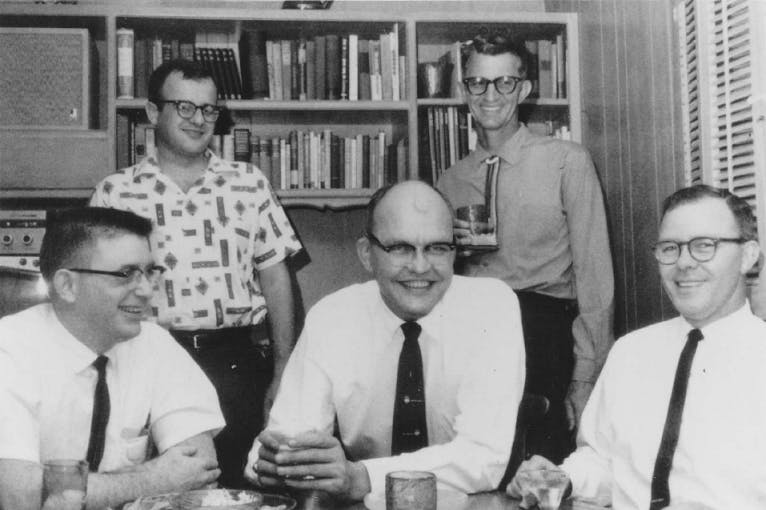
Around the Dallas campus of Texas Instruments, Jack Kilby is known as the humble giant, a nod to his modesty and his six-foot, six-inch frame. But he’s a giant in terms of his accomplishments too: As the co-inventor of the integrated circuit, otherwise known as the silicon microchip, he’s the one we have to thank for everything from electronic watches to personal computers to cellular phones.
These days Kilby is still thinking big, dreaming up new applications for his little chip. At 76, he’s in good health; the thick glasses, hearing aids, and halting speech are the only signs of his age. Every morning just after seven-thirty, he leaves his house—the same one he bought when he first went to work for TI in 1958—and drives his shiny new Lexus to his North Dallas office, where he does a little consulting. And once a week he goes to TI, where he advises engineers.
How Kilby changed the course of high-tech history is one of the industry’s most storied tales. After earning degrees in electrical engineering from the University of Illinois and the University of Wisconsin, the Jefferson City, Missouri, native went to work at Milwaukee-based Centralab, helping to develop a ceramic-based circuit to be used in consumer electronics. But after eleven years, he realized that the future was in silicon, so he took a job as a project engineer at TI.
Kilby was assigned to study ideas for miniaturizing the electric circuit. He started work just before many of his co-workers and his boss were taking off for summer vacations. Alone in the lab, poring over various schemes, he came to the conclusion that all the parts and pieces, from transistors to diodes, could be made out of silicon and integrated on a chip.
When his boss returned to work, Kilby showed him a sketch of his idea and a couple of months later presented him with a prototype containing one transistor, four resistors, and three capacitors. “There was a little skepticism,” Kilby says, “mostly about how to produce these things in quantity.” Initially his invention had only specialized applications—the Pentagon used it to power computers and weapons systems in the early sixties—but once TI resolved the production issues, the commercial uses increased; Digital Equipment Corporation’s first minicomputers, for instance, ran on Kilby’s minichips.
After Kilby developed his integrated circuit, he went on to co-invent the pocket calculator, which debuted in 1965—”An attempt,” he says, “to show that the chip could be made accessible to a mass market.” In 1970 he quit TI to work as a freelance inventor (he briefly worked on a project that would have used silicon technology to generate electricity from sunlight) and set up his consulting business.
Over the years, Kilby has been recognized multiple times for his accomplishments. In 1969 he was awarded the National Medal of Science, and in 1982 he was inducted into the National Inventors Hall of Fame, joining, among others, Henry Ford, Thomas Edison, and the Wright brothers. In 1997 TI named its new $154 million research-and-development center after him and gave his charitable foundation $1 million to honor scientists and inventors. Kilby is almost embarrassed when asked about his fame. “It has reached far beyond anything that I would have expected,” he says.
Kilby has been spending his time recently thinking about biotechnology. He believes that if a certain number of test tubes could somehow be placed on a single computer chip, scientists could put a drop of blood or saliva on it, run it through a computer, and get back a complete medical workup. Indeed, if he were a young inventor, he says he’d be working on “some form of biotech.”
Any other advice he’d give someone just getting started today? “Pick something you’re interested in—and go as far as you can with it.”
BIZ O METER
The Container Store, Dallas.
Organize this: It’s the best company in the country to work for, according to Fortune.
George Foreman, Houston
A knockout: The two-time heavyweight champ signed a $137.5 million lifetime endorsement deal with housewares manufacturer Salton.
Mark Cuban, Dallas
Jump ball: It’s well and good to pay $280 million for a pro sports team. But the Dallas Mavericks?
Carole Keeton Rylander, Austin
Tone deaf: The Texas comptroller’s midnight raid of blues mecca Antone’s collected more bad karma than back taxes.
Tony Sanches, Laredo
Artless: Sophisticates blame the blustery University of Texas regent for the resignation of Swiss artictects hired to design UT-Austin’s new museum.






